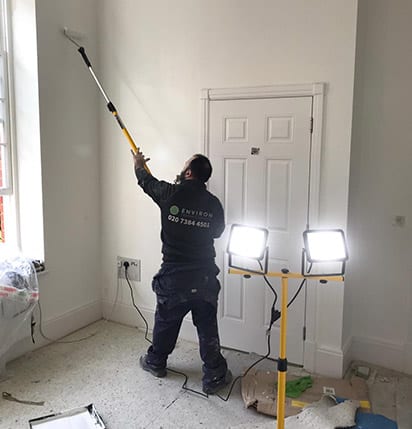
Damp proof paints and renders contain plastics which form a waterproof seal when applied to a wall. They’re ideal for modern buildings, but can have disastrous impacts on period properties.
You may think that completely stopping any water entering your home is the best way to prevent damp, but the opposite is true when it comes to solid brick buildings.
Yes, you’ll stop rainwater from entering the wall, but you’ll also stop interior moisture from escaping. This leads up a build-up of moisture inside the walls, resulting in severe damp and mould.
Why can’t I use waterproof paint on a solid brick wall?
The reason bricks were our favourite building material for hundreds of years is their breathability. Moisture is absorbed and then evaporates through their sponge-like structure, which prevents build up of damp.
Modern buildings are designed so that no water passes through the main structure and interior moisture is entirely controlled through ventilation.
Old buildings with solid brick walls work very differently. Bricks act like a sponge, absorbing and then releasing moisture through their porous structure. This works the same way whether it’s exterior moisture from rain or interior moisture from cooking, cleaning or laundry.
This is known as the building “breathing”, and allowing brick walls to behave as they’re supposed to is key to preventing the build up of damp and mould.
But I don’t want to live in a draughty house
Don’t confuse moisture evaporation through brickwork with air passing through your walls. A building can be completely sealed against cold draughts while still allowing the brickwork the breathe.
This is the correct approach to controlling temperature and moisture in a period property without interfering with the natural breathability of bricks.
Of course, you still need ventilation to get rid of stale air and prevent excessive moisture build up and condensation. Ventilation can be easily installed for a pennies-a-day running cost with a PIV unit.
Learn more about PIV unit installation.
If I can’t use waterproof paint on the exterior, how do I stop water getting in?
Damp can enter your home from the outside, known as penetrating damp. But the solution to penetrating damp isn’t to completely seal up the exterior wall, it’s to repair it to a high quality.
Penetrating damp isn’t caused by natural water absorption of bricks, it’s caused by cracks in brickwork or pointing which allows water to seep into the building. These cracks widen over time through erosion and freeze-throw damage.
You should regularly have the outside of your building inspected for cracks or decayed pointing so that they can be repaired before penetrating damp develops.





